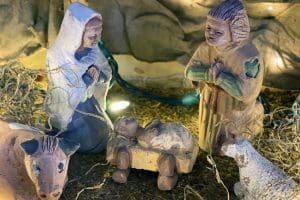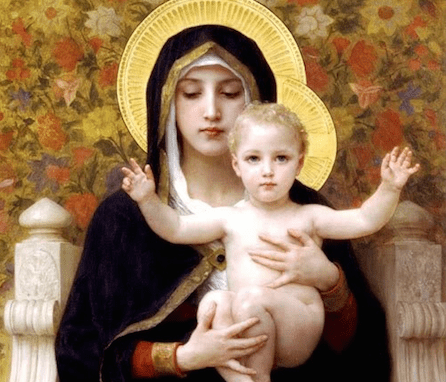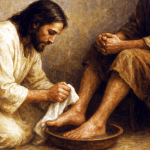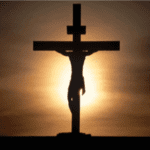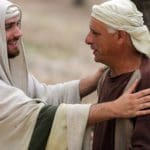Finders Keepers
I think the most surprising part of Lehi’s– and later, Nephi’s—vision of the Tree of Life, is that some people hold to the rod and partake of the fruit, and then become ashamed and fall away (Nephi 4:24-28). You expect some folks to fall away before their destination, and others never even to attempt the journey. And, of course, we expect people to succeed in their attempt, taste the fruit, and stay faithful. But we feel particular pain and even confusion, in behalf of those who made it all the way, tasted of “the greatest of all the gifts of God,” and still chose to turn their backs on that incredible reward. They find it, but they don’t keep it.
It’s puzzling. But then, look at what’s happening right now. How many of those who are baptized, shortly fall inactive? Why is the average activity level in our wards only fifty per cent? How is it that so many returned missionaries fall away? How can you be so thrilled to find the truth, and then turn from it?
We all know the answers. The first was best summarized by a man I once heard, who said, “The reason people fall away from the church is the same reason they fall out of bed—they’re not in properly.” And, without question, even a returned missionary can fall prey to the shallow roots problem of not ever having had a genuine testimony. Surely there are some who are baptized without honestly feeling a witness from the Holy Ghost. Thousands of members are just “cultural Mormons” who never had that turning point when they knew, solid and sure, that the church was true. These are the souls Satan marks as easy targets—they can be blown down like a house of straw.
Another reason is accommodation. They know it’s true, but they have family pressure that makes attendance a point of contention. Or they don’t wish to live the commandments fully, and feel too guilty to attend. (Yes, they should still come, but they don’t.) Maybe they know it’s true, but they don’t want to commit to that much involvement, that much time. Or they’ve been offended and they choose to nurse those hurt feelings rather than renew their baptismal covenants each week. Maybe they’ve fallen into the habit of not attending, and lack the drive to come back. Sometimes we accommodate our weaknesses even more than our schedules or other demands.
Another reason can be that they don’t have friends or feel needed. This is why President Hinckley told us that new members need a friend, an assignment, and to be “nurtured by the good word of God” (Moroni 6:4). Too many new members feel all the flurry of attention has died down, and there’s no place for them to serve and get involved. Yes, we can say that you have to walk on your own at some point, but shame on us for not extending the hand of friendship whenever we can. Every time I hear about an “unfriendly ward” where people lived for months without a visit or a calling, I cringe. And anyway, Christ has never once told us to walk on our own, has he? He has always been there to help us. Should we be any different?
Rekindling the faith of one who has fallen away does not always need to be grandiose. Simply inviting someone to come and sit with you at church, or to help you teach an evening Relief Society class, or to sing in the choir, can be the turning point. Maybe they’re just waiting for one person to care.
I recall watching a training video in Ward Council, in which Elder David A. Bednar spoke of tremendous success he had in bringing people back, simply by going to their homes and asking them to share their initial conversion story. He would ask them if they’d like that power of the Priesthood again to bless their life, and the lives of their children. Sometimes they just need to remember what it felt like when the Holy Ghost told them this was Christ’s true church, restored.
Satan has mastered the art of lulling us into a state of complacency. He uses laziness, self-pity, distractions, and cynicism to get us to miss a few times, then quickly points out that you’re still doing fine, so why go back now? And the next thing you know, years have passed. New habits have replaced old ones. It’s easier to maintain the current state than embark upon a new one even if we know better.
We see the same phenomenon with temple attendance. How many endowed members become lax in their attendance, allow their recommends to expire, and then just roll along without that blessing in their lives? Too many.
I love what President Hinckley said in his April Conference address of 1999, Find the Lambs, Feed the Sheep: “There is absolutely no point in doing missionary work unless we hold on to the fruits of that effort. The two must be inseparable. These converts are precious. Every convert is a son or daughter of God. Every convert is a great and serious responsibility. It is an absolute imperative that we look after those who have become a part of us. To paraphrase the Savior, what shall it profit a missionary if he baptize the whole world unless those baptized remain in the Church? (see Mark 8:36).”
We often rave about how many baptisms there are in one village, or one area of the world. As if on fire with the Spirit, whole communities line up and missionaries are thrilled. But perhaps we should remember President Hinckley’s words and give equal applause to those flocks who stay. And the local members who work to make it so, long after the missionary is gone.
Finding the church is often the easy part. But keeping it is tricky. Once we taste of the fruit, let us turn to those around us and hug them, rejoice with them, buoy them up when trials appear, and remind them of what they know is true. When we see someone drifting away, let us run after that lost sheep and bring them back. There’s infinite room under that tree. And better still, infinite joy.
Hilton’s new LDS novel, Golden, is available in paperback and on Kindle. All her books and YouTubeMom videos can be found on her website. She currently serves as a Relief Society President.
What Does the Virgin Mary Have to Do with the Tree of Life?
To sign up for Meridian’s Free Newsletter, please CLICK HERE.
“Behold, the virgin whom thou seest is the mother of the Son of God, after the manner of the flesh.” (1 Nephi 11:18)
The Know
When Nephi asked the Spirit of Lord the meaning of the tree seen in his father’s dream (1 Nephi 11:11), the Spirit seemingly changed the subject, and called Nephi’s attention to “a virgin.” Nephi said that “she was exceedingly fair and white,” and “most beautiful and fair above all other virgins” (1 Nephi 11:13, 15).
As this vision proceeds, Nephi sees this woman “bearing a child in her arms” (1 Nephi 11:20), and the angel escorting him told Nephi that she is “the mother of God, after the manner of the flesh,” as found in the original text.[i] From this vision, Nephi somehow comes to understand the meaning of the tree of life (1 Nephi 11:21–22).
In 1998, Daniel C. Peterson noted a fundamental connection between the tree and virgin. The adjectives describing the virgin (“most beautiful,” “exceedingly fair,” “white”) compared to those describing the tree (“exceeding all beauty,” and “exceed[ing] the whiteness of the driven snow”), are synonyms (1 Nephi 11:8).
Just as the tree bore fruit, the virgin bore a child (1 Nephi 11:7, 20). “Clearly,” Peterson noted, “the glimpse given to Nephi of the virgin mother with her child is the answer to his question about the meaning of the tree. Indeed, it is evident that, in some sense, the virgin is the tree.”[ii]
As Peterson goes on to explain, scholars have recently come to accept that in ancient Israelite religion, there was a belief in a divine mother goddess named Asherah, who was represented by the tree of life. The symbolism is widespread throughout the ancient Near East, and can be seen in association with different goddesses by various cultures.
In 2011, Egyptologist John S. Thompson went on to explore additional connections between different Egyptian goddesses and sacred trees. Thompson notes that while most ancient Near Eastern cultures sexualized the tree goddess, the Egyptians emphasized the motherly role, often depicting tree goddesses nursing a child.[iii] The Israelite Asherah was likewise more focused on the nursing mother and less sexualized—she was the “mother of the gods” and also regarded as the mother of the Davidic kings.[iv]
The Why
Nothing is more important in Christian worship than to recognize Jesus Christ as the Son of God, born of a virgin, who became flesh as the express image of his Father (John 17:3; Hebrews 1:1–3).
The Book of Mormon, as another witness and covenant of God, testifies “that Jesus is the Christ, the Eternal God” as he “manifest[s] himself unto all nations” (Book of Mormon Title Page). The ancient abridger Mormon testified that he had written this book “for the intent that ye may believe” the Bible, and so that modern people may know of the marvelous and miraculous works that have been brought to pass “by the power of God among them” (Mormon 7:9).
The notion of a divine mother goddess strongly resonates with Latter-day Saint belief in a Heavenly Mother.[v] While Mary is not to be identified as Heavenly Mother, the ancient Israelite and Egyptian cultural backgrounds shed light on Nephi’s vision and how he made sense of imagery.
Just as Israelite and Egyptian religions associated a sacred tree with a mother of gods and kings, so did Nephi’s guide tie the idea of the tree of life together with the “mother of God, after the manner of the flesh,” whose child was the Messiah, the true Davidic King.
People everywhere can appreciate the beautiful force and effect of Nephi’s revelation. Samuel Zinner, a non-LDS scholar of Enoch studies, has remarked that the symbolism in Nephi’s vision, “implies a theological … continuity between the tree of life, Lady Jerusalem, Lady Nazareth, and the Virgin Mary. These are all ultimately specializations or refractions of Asherah.”[vi]
Margaret Barker, another non-LDS Old Testament scholar, has marveled that Nephi’s vision “is the Heavenly Mother, represented by the tree of life, and then Mary and her Son on earth. This revelation to Joseph Smith was the ancient Wisdom symbolism, intact, and almost certainly as it was known in 600 BCE.”[vii]
By Book of Mormon Central
Visit our website at https://www.bookofmormoncentral.org
Further Reading
Gospel Topics, “Mother in Heaven,” on lds.org at https://www.lds.org/topics/mother-in-heaven?lang=eng
David L. Paulsen and Martin Pulido, “‘A Mother There’: A Survey of Historical Teachings about Mother in Heaven,” BYU Studies 50, no. 1 (2011): 70–97.
Samuel Zinner, “‘Zion’ and ‘Jerusalem’ as Lady Wisdom in Moses 7 and Nephi’s Tree of Life Vision,” Interpreter: A Journal of Mormon Scripture 12 (2014): 281–323.
John S. Thompson, “The Lady at the Horizon: Egyptian Tree Goddess Iconography and Sacred Trees in Israelite Scripture and Temple Theology,” in Ancient Temple Worship: Proceedings of The Expound Symposium, 14 May 2011, ed. Matthew B. Brown, Jeffrey M. Bradshaw, Stephen D. Ricks, and John S. Thompson (Orem, Utah: Interpreter Foundation and Eborn Books, 2014), 217–241.
Daniel C. Peterson, “A Divine Mother in the Book of Mormon?” in Mormonism and the Temple: Examining an Ancient Religious Tradition, ed. Gary N. Anderson (Logan, Utah: Academy for Temple Studies and USU Religious Studies, 2013), 109–124.
Margaret Barker, “The Fragrant Tree,” in The Tree of Life: From Eden to Eternity, ed. John W. Welch and Donald W. Parry (Salt Lake City, Utah: Deseret Book and Neal A. Maxwell Institute, 2011), 55–79.
Margaret Barker, “Joseph Smith and Preexilic Israelite Religion,” in The Worlds of Joseph Smith, ed. John W. Welch (Provo, UT: Brigham Young University Press, 2005), 69–82.
Daniel C. Peterson, “Nephi and His Asherah,” Journal of Book of Mormon Studies 9, no. 2 (2000): 16–25.
Daniel C. Peterson, “Nephi and His Asherah: A Note on 1 Nephi 11:8–23,” in Mormons, Scripture, and the Ancient World: Studies in Honor of John L. Sorenson, ed. Davis Bitton (Provo, Utah: FARMS, 1998), 191–243.
[i] Royal Skousen, ed., The Book of Mormon: The Earliest Text (New Haven, CT: Yale University Press, 2009), 29.
[ii] Daniel C. Peterson, “Nephi and His Asherah: A Note on 1 Nephi 11:8–23,” in Mormons, Scripture, and the Ancient World, ed. Davis Bitton (Provo, UT: FARMS, 1998), 194.
[iii] John S. Thompson, “The Lady at the Horizon: Egyptian Tree Goddess Iconography and Sacred Trees in Israelite Scripture and Temple Theology,” in Ancient Temple Worship: Proceedings of The Expound Symposium, 14 May 2011, ed. Matthew B. Brown, Jeffrey M. Bradshaw, Stephen D. Ricks, and John S. Thompson (Orem, Utah: Interpreter Foundation and Eborn Books, 2014), 225–226.
[iv] Peterson, “Nephi and His Asherah,” 196–198.
[v] See “Mother in Heaven,” online at https://www.lds.org/topics/mother-in-heaven?lang=eng (accessed October 28, 2015).
[vi] Samuel Zinner, “‘Zion’ and ‘Jerusalem’ as Lady Wisdom in Moses 7 and Nephi’s Tree of Life Vision,” Interpreter: A Journal of Mormon Scripture 12 (2014): 313.
[vii] Margaret Barker, “Joseph Smith and Preexilic Israelite Religion,” in The Worlds of Joseph Smith, ed. John W. Welch (Provo, UT: Brigham Young University Press, 2005), 76.
Book of Mormon Extras Lesson 3 – Joseph Smith’s Father Saw the Tree of Life 19 Years Before the Book of Mormon was Published
Please don’t miss another story like this one. Sign up for our Free Newsletter here.
Personal Scripture Study
I love to read the scriptures. But I love even more to study the scriptures, to find myself on a meandering path through doctrine, history, culture, discovery and personal revelation. This week’s lesson on the Tree of Life is a perfect opportunity to go down that path.
Seed
First of all, there’s a big clue to this whole chapter (1 Nephi 8) in the first verse. It seems like a very trivial thing, but it’s not. Nothing in the Book of Mormon is happenstance or trivial.
“And it came to pass that we had gathered together all manner of seeds of every kind, both of grain of every kind, and also of the seeds of fruit of every kind.”
What an interesting introduction to the vision of the Tree of Life. Lehi is going to tell us about the seed HE has gathered—about Lehi’s posterity and the whole dream hinges on his own concerns for his family.
Only a Small Part
Verses 29 and 30 intrigue me. “And now I, Nephi, do not speak all the words of my father. But, to be short in writing…” Please! Don’t be short! I want all his words! Give me more! We see this same pattern in many places in the scriptures.
Joseph Smith does this same thing in the 1838 canonical account of the First Vision: “…and many other things did he say unto me, which I cannot write at this time.” (JSH 1:20) NO! I want more, more, more!
Joseph does it again when he talks of the vision of Moroni: “He quoted many other passages of scripture, and offered many explanations which cannot be mentioned here.” (JSH 1:41) Ahhhh! I would love to have all those explanations and scriptures.
I once type-scripted all the things that Joseph recorded Moroni said, including the long form of every scripture he referred to and some brief history and some added-in words of the history of the Nephites, etc. I read it slowly aloud. It took me about 16 minutes! Yet, the three visits of Moroni took the whole of the night! Those small phrases in verses 20 and 41 of the Joseph Smith History account for the vast majority of the experiences Joseph had!
Mormon does the same thing in his record. Four different times he essentially says: “And now there cannot be written in this book even a hundredth part of the things…” (see Words of Mormon 1:5; 3 Nephi 5:8; 3 Nephi 26:6 and Helaman 3:14). Jacob, Nephi’s brother, says the same thing: “And a hundredth part of the proceedings of this people…cannot be written upon these plates…” (Jacob 3:13). Mormon says in another place, “Behold, I was about to write the names of those who were never to taste of death, but the Lord forbade; therefore I write them not, for they are hid from the world.” Again, I want to know these things!
John refers to this same issue: “And there are also many other things which Jesus did, the which, if they should be written every one, I suppose that even the world itself could not contain the books that should be written.” (John 21:25)
Back to the Tree of Life: Nephi only gives us a part of his father’s words, but then he does show us a pattern of how to obtain the rest of them. I will talk about that pattern in a subsequent article for Lesson 4.
The Tree of Life in Numerous Cultures
The Tree of Life plays an important role in numerous ancient and modern cultures and religions. It is found throughout ancient Iran or Persia. It was found in ancient Egypt where the spheres of the Tree of Life demonstrated the order, the process and method of creation. It was drawn on the fortresses and the armor of ancient Armenia. It was found in Assyria. It is important in the Baha’i Faith. It is central to Buddhism. It was under this tree (called the Bo Tree) where the Buddha sat and obtained Enlightenment. It is important to ancient Chinese traditions. The list could go on and on.
The Tree of Life in Creation
From the Books of Genesis and Abraham we learn the significant location of the Tree of Life. It was “in the midst of the garden.” (see Genesis 2:9 and Abraham 5:9). The midst is the middle or center of the Garden of Eden. But we learn more about its location: “And a river went out of Eden to water the garden; and from thence it was parted, and became into four heads.” (see Genesis 2:10; Abraham 5:10; Moses 3:10). It appears then that the river flowed from the center of the garden, or from the Tree of Life itself and then watered the whole earth. For the water to flow from the tree or the midst or middle of the garden, based on the law of gravity, that center place had to be the highest point of the garden. So, the whole earth received its nourishment from the Tree of Life.
Joseph Smith’s Father Sees the Tree of Life
Lehi and Nephi are not the only ones to have a vision of the Tree of Life. Joseph Smith’s father saw the Tree of Life vision at least 9 years before the First Vision and 19 years before the Book of Mormon was published!
Consider the vision of Joseph Smith, Sr. in 1811 as recorded in Lucy Mack Smith’s history compared back and forth with Lehi’s vision:
“I thought,” said [Joseph Smith, Sr.], “I was traveling in an open, desolate field which appeared to be very barren. As I was thus traveling, the thought suddenly came into my mind that I had better stop and reflect upon what I was doing before I went any farther. So I asked myself, ‘What motive can I have in traveling here, and what place can this be?’”
Notice in Lehi’s vision he says: “methought I saw in my dream, a dark and dreary wilderness.”
Joseph Smith, Sr. continues:
“My guide, who was by my side as before, said, ‘This is the desolate world, but travel on.’ The road was so broad and barren that I wondered why I should travel in it, for, said I to myself, ‘Broad is the road, and wide is the gate that leads to death, and many there be that walk therein; but narrow is the way, and strait is the gate that leads to everlasting life, and few there be that go in thereat.’”
Lehi recorded: “And it came to pass that as I followed him [his guide] I beheld myself that I was in a dark and dreary waste. And after I had traveled for the space of many hours in darkness, I began to pray unto the Lord that he would have mercy on me, according to the multitude of his tender mercies.”
Joseph Smith, Sr. continued:
“Traveling a short distance further, I came to a narrow path. This path I entered, and, when I had traveled a little way in it, I beheld a beautiful stream of water which ran from the east to the west. Of this stream I could see neither the source nor yet the mouth, but as far as my eyes could extend I could see a rope, running along the bank of it about as high as a man could reach, and beyond me was a low but very pleasant valley in which stood a tree such as I had never seen before. It was exceedingly handsome, insomuch that I looked upon it with wonder and admiration. Its beautiful branches spread themselves somewhat like an umbrella, and it bore a kind of fruit, in shape much like a chestnut bur, and as white as snow, or, if possible, whiter. I gazed upon the same with considerable interest, and as I was doing so, the burs or shells commenced opening and shedding their particles, or the fruit which they contained, which was of dazzling whiteness. I drew near and began to eat of it, and I found it delicious beyond description.”
Lehi said of his vision: “And it came to pass that I beheld a tree, whose fruit was desirable to make one happy. And it came to pass that I did go forth and partake of the fruit thereof; and I beheld that it was most sweet, above all that I ever before tasted. Yea, and I beheld that the fruit thereof was white, to exceed all the whiteness that I had ever seen.”
Joseph Smith, Sr. recorded:
“As I was eating, I said in my heart, ‘I cannot eat this alone, I must bring my wife and children, that they may partake with me.’ Accordingly, I went and brought my family, which consisted of a wife and seven children, and we all commenced eating and praising God for this blessing. We were exceedingly happy, insomuch that our joy could not easily be expressed.”
Lehi said: “And as I partook of the fruit thereof it filled my soul with exceedingly great joy; wherefore, I began to be desirous that my family should partake of it also; for I knew that it was desirable above all other fruit. And as I cast my eyes round about, that perhaps I might discover my family also…”
Both Lehi and Joseph Smith, Sr. could not partake of the fruit alone, they had to share it with their family and gather their families in to them (remember gathering seed of every kind?).
Joseph Smith, Sr. continued:
“While thus engaged, I beheld a spacious building standing opposite the valley which we were in, and it appeared to reach to the very heavens. It was full of doors and windows, and they were all filled with people, who were very finely dressed. When these people observed us in the low valley, under the tree, they pointed the finger of scorn at us, and treated us with all manner of disrespect and contempt. But their contumely we utterly disregarded.”
Lehi’s vision was similar: “And I also cast my eyes round about, and beheld, on the other side of the river of water, a great and spacious building; and it stood as it were in the air, high above the earth. And it was filled with people, both old and young, both male and female; and their manner of dress was exceedingly fine; and they were in the attitude of mocking and pointing their fingers towards those who had come at and were partaking of the fruit.”[i]
Joseph Smith, Sr. was given special instructions to gather his own seed in the vision:
“I presently turned to my guide and inquired of him the meaning of the fruit that was so delicious. He told me it was the pure love of God, shed abroad in the hearts of all those who love him and keep his commandments. He then commanded me to go and bring the rest of my children. I told him that we were all there. ‘No,’ he replied, ‘look yonder, you have two more, and you must bring them also.’ Upon raising my eyes, I saw two small children standing some distance off. I immediately went to them and brought them to the tree, upon which they commenced eating with the rest, and we all rejoiced together. The more we ate, the more we seemed to desire, until we even got down upon our knees and scooped it up, eating it by double handfuls.”
Their joy could not be contained in partaking of the fruit together. Joseph Smith, Sr. concluded by asking what the meaning of the building was:
“After feasting in this manner a short time, I asked my guide what was the meaning of the spacious building which I saw. He replied, ‘It is Babylon, it is Babylon, and it must fall. The people in the doors and windows are the inhabitants thereof, who scorn and despise the Saints of God because of their humility.’ I soon awoke, clapping my hands together for joy.”[ii]
Nephi also explained the meaning of the spacious building from his own vision:
“And the multitude of the earth was gathered together; and I beheld that they were in a large and spacious building, like unto the building which my father saw. And the angel of the Lord spake unto me again, saying: Behold the world and the wisdom thereof; yea, behold the house of Israel hath gathered together to fight against the twelve apostles of the Lamb. And it came to pass that I saw and bear record, that the great and spacious building was the pride of the world; and it fell, and the fall thereof was exceedingly great. And the angel of the Lord spake unto me again, saying: Thus shall be the destruction of all nations, kindreds, tongues, and people, that shall fight against the twelve apostles of the Lamb.”[iii]
The Real Meaning to the Tree of Life
Nephi’s greatest desire in his own vision was not only to see the Tree of Life, but to understand what it was. When he was shown the tree by the Spirit, Nephi is asked what he wanted. “To know the interpretation thereof…”[iv] He wanted to know what the Tree meant.
An angel comes and shows him a series of visions. Nephi first sees Jerusalem (to give him orientation, I suppose) and many other cities in his ancient homeland. He is then shown Nazareth. In the city of Nazareth he sees a virgin who is exceedingly fair and white, and “most beautiful and fair above all other virgins.”[v]
Remember: Nephi has asked to know what this symbol of the Tree of Life means. He is shown all these things. He is then asked a question that he does not know the answer to: “Knowest thou the condescension of God?” Nephi fumbles for an answer, “I know that he loveth his children; nevertheless, I do not know the meaning of all things.”[vi]
The angel puts everything together now for Nephi:
“Behold, the virgin whom thou seest is the mother of the Son of God, after the manner of the flesh. And it came to pass that I beheld that she was carried away in the Spirit; and after she had been carried away in the Spirit for the space of a time the angel spake unto me, saying: Look! And I looked and beheld the virgin again, bearing a child in her arms.”[vii]
Then the angel says to Nephi, essentially, “NOW do you know the meaning of the Tree?” He does. The Tree of Life is the perfect representation of the Son of God—of Jesus Christ Himself. It is not just the ethereal love of God, or a symbolic manifestation of the sweetness of the Gospel, it is Jesus Christ—all those who come to the Tree are coming to partake of the Atonement of Jesus Christ and receive eternal life.
The first verse of the chapter now makes more sense about gathering all manner of seed. We are all to gather to the Tree—to come to the Atonement of Jesus Christ. And who are the seed of Christ?
“Behold I say unto you, that whosoever has heard the words of the prophets, yea, all the holy prophets who have prophesied concerning the coming of the Lord—I say unto you, that all those who have hearkened unto their words, and believed that the Lord would redeem his people, and have looked forward to that day for a remission of their sins, I say unto you, that these are his seed, or they are the heirs of the kingdom of God.”[viii]
This makes the dream or vision of Lehi and of Joseph Smith, Sr. all the more powerful—these are essential stories (in all cultures) to bring us to the Son of the Most High God, to Jesus Christ, the Messiah, the Savior of all. How blessed we are to have these visions recorded.
Notes
[i] See 1 Nephi 8: 2-28.
[ii] See Smith, Lucy Mack. The Revised and Enhanced History of Joseph Smith by His Mother. Edited by Scot Facer Proctor and Maurine Jensen Proctor. Bookcraft, Salt Lake City, Utah, 1996, pp. 64-66.
[iii] 1 Nephi 11: 35, 36.
[iv] 1 Nephi 11:11.
[v] 1 Nephi 11:13-15.
[vi] See 1 Nephi 11:16-17.
[vii] 1 Nephi 11:18-20.
[viii] Mosiah 15:11.
Lesson 3: “The Vision of the Tree of Life”
1 Nephi 8-11; 12:16-18
Even as Joseph of Egypt, his forebear, Lehi was a dreamer. Dreams and visions had shown him the impending destruction of Jerusalem and the coming of the Messiah. Obedience to the Lord’s command in a dream led him away from his homeland. Now Lehi was about to have another transcendent dream which was in part a response to something on his mind-seed. As chapter 8 opens, Lehi and his family are gathering seed of every kind to take into the wilderness, but a parallel theme is sounded here. Earlier the Lord had told him that “his sons should take daughters to wife, that they might raise up seed unto the Lord” (1 Nephi 7:1) Lehi has two rebellious sons, Laman and Lemuel. What will become of his seed as their family travels toward a promised land where a new civilization will be established?
His marvelous dream is, in part, a response to those worries. It is a vision of comfort and expanse, centered on the tree of life, an archetypal image so expressive of life’s ultimate spiritual meaning that it appears in many ancient cultures. Some scholars suggest that it is under a tree of life that Buddha sat; they say the Jewish menorah is another form of the tree.
The Centerpiece
The centerpiece of the dream is a tree of exceeding beauty “whose fruit was desirable to make one happy”(8:11). This fruit is so delicious, so exquisite that it brings exceeding joy. Indeed, in Joseph Smith Sr.’s similar dream, the fruit is so enormously enjoyable–beyond anything in this world–that “the more we ate, the more we seemed to desire, until we even got down upon our knees and scooped it up, eating it by double handfuls.” What is this tree that is so irresistibly delicious? Our quick answer is the “love of God,” which is indeed correct, but a more detailed answer is given Nephi in chapter 11 when he, too, sees this tree whose “beauty was far beyond, yea exceeding of all beauty” (11:10). Then he is told what the tree represents as the Spirit shows him the Son of God–his condescension to come to earth, his life, and sacrifice. The tree of life is a symbol of Jesus Christ whose coming here is the ultimate expression of God’s love for us. “For God so loved the world that he gave his only begotten Son…” (John 3:16). The tree is the Savior and his atonement that is represented as so inexpressibly beautiful and sweet.
In this pivotal symbol of a tree converges all the meaning of the gospel. It was the tree of life that stood in the Garden of Eden and nourished Adam and Eve. This was a place of unity with each other and with the Lord. After they fell, eating the fruit of a forbidden tree, they came into a world of duality, division, separation from God. The only way to be at-one again with the Lord comes from the events that took place on another tree–the cross, through Christ’s atonement and resurrection. Some legends even claim the cross was constructed from a branch of the tree of life. Symbolically, at least, this is true.
The tree of life is mentioned again in Alma 32. This time the discussion centers on comparing the word (another designation for Jesus Christ) to a seed. If you plant the word or seed in your heart and nurture it with great diligence and patience, “it shall take root; and behold it shall be a tree springing up into everlasting life” (Alma 32:41).
Notice how personal the idea of eating of the fruit is. Something you eat becomes a part of you. It transforms your very system. Christ’s mission has done the same for us, transforming us from what we were before to a new person–born again.
The fruit of this tree of life was so delicious that Lehi didn’t want to enjoy it alone but immediately looked for his family members to come and eat too. The symbol here was not just of salvation but of an entire family coming to eternal life. Lehi was anxious that not one be lost. He wanted to gather the “seeds of every kind.”
Desert Images
The images that came to Lehi as he stood by the tree in his dream are those of a man of the desert. He saw a river of water leading to the tree and looked to see its source, as a desert dweller would. Then, he saw that many of those who pressed toward the tree became lost in a mist of darkness. The wanderer in the desert can be overtaken by thick, low-lying impenetrable mists that move rapidly through a region and blind all who would travel on.
On the other side of the river from the tree was “a great and spacious building …high above the earth…filled with people…in the attitude of mocking and pointing their fingers towards those who…were partaking of the fruit.” (1 Nephi 8:26,27). The building is high above the air because it has no foundation. These mockers who would belittle others are the very antithesis of Jesus Christ, and the kind of gulf that separates them from the righteous would have been a common sight in Lehi’s desert.
Nephi’s Response
When Laman and Lemuel heard of their father’s vision, they responded by arguing heatedly in their tent about what it meant. Nephi asked what to him was a most natural question, “Have ye inquired of the Lord?” (1 Nephi 15:8). He knew from the most intimate firsthand experience from the Lord from whom they could obtain answers–“Ask, and it shall be given unto you”–but their reply was telling. “We have not; for the Lord maketh no such thing known unto us” (15:9). That paradigm itself sealed their doom, was the mental filter through which all their experience would flow. Believing that the Lord would make no such thing known to them, they wouldn’t ask, wouldn’t trouble themselves, and their belief became its own self-fulfilling prophecy. Nephi would climb the mountain; they would grovel in the tent.
Nephi believed that “he that diligently seeketh shall find” and with that belief approached the Lord. His desire was intense and he was rewarded by being taken to an exceedinly high mountain and being asked a powerful question, “What desirest thou?” (11:1). He was taught as his father had been before him.
Holy Days and Heavenly Mothers
Each Mother’s Day, I’ve gotten into the habit of reflecting on the idea of a Heavenly Mother in Mormonism (I wrote a short piece on this last year, which you can read here). Last year’s reflection stuck with me into the Christmas season, when I realized how closely Christmas was tied to Mother’s Day. Up until then, I was absolutely convinced that the greatest lesson of the Christmas story was Christ’s willingness to condescend from heaven and to become vulnerable by becoming human—an all-powerful God proving to us that both he and the Father have hearts that beat in sympathy with ours.[1]
But as I revisited the Christmas story this last December, I noticed something that I had previously been blind to—an even greater truth that has transformed my heart and my imagination. I still think that Christ’s vulnerability is a vital part of what Christmas “means,” but perhaps understanding that vulnerability this Mother’s Day can, in turn, help us to understand something equally profound—the truly divine power of Motherly love.

Winchester Cathedral, Burne Jones, The Nativity, Adoration of the Shepherds
Christmas and Vulnerability
Let’s start with how the Christmas story relates to vulnerability. In the Book of Mormon, King Benjamin delivers what might be considered the book’s first Christmas sermon, but he doesn’t talk about Christmas in the way that we’re most familiar with. Quoting an angel, Benjamin tells his people that “the time cometh, and is not far distant, that with power, the Lord Omnipotent who reigneth, who was, and is from all eternity to all eternity, shall come down from heaven among the children of men, and shall dwell in a tabernacle of clay, and shall go forth amongst men.” Immediately after this, Benjamin tells us that by choosing to be born into this “tabernacle of clay,” Jesus makes himself vulnerable to “temptations,…pain of body, hunger, thirst, and fatigue” (Mosiah 3:5, 7).
Here, Benjamin suggests that, for a God, to become human means to become vulnerable—to be susceptible to pain, hunger, thirst, fatigue, and everything else that we may struggle with. For Benjamin, one of the true miracles of Christmas was the fact that Jesus, “the Lord Omnipotent,” chose to become absolutely vulnerable—not just to the vicissitudes of life, but to life itself. Births are risky, and were even more so in the ancient world. There was no modern sense of sterility at birth sites and certainly no modern medical equipment. Rooms were dirty, made even dirtier by the noisy animals all around, and as if to highlight this point, Luke tells us that Jesus was placed in an animal’s feeding trough after he was born (Luke 2:7). A holy night, but in less-than-holy surroundings.

Benjamin continues his sermon with the following, “And he shall be called Jesus Christ, the Son of God, the Father of heaven and earth, the Creator of all things from the beginning; and his mother shall be called Mary” (Mosiah 3:8). This last statement puts us firmly into a Christmas setting, and for all of Jesus’ glory and greatness, in the end, Benjamin points us back to Mary, the mother of God.
Earlier in the Book of Mormon, Nephi’s Christmas encounter also deals with this theme of vulnerability. When Nephi asks to understand the tree in Lehi’s dream, an angel begins by showing Nephi a virgin (“most beautiful and fair above all other virgins”) in the city of Nazareth (1 Nephi 11:13-15). The angel then asks Nephi, “Knowest thou the condescension of God?” For us Christians, the answer seems obvious—this is virgin is Mary, and God is going to “condescend”—to voluntarily lower himself from the glory of heaven to the mud of the earth—by being born as a human.
But Nephi is genuinely stumped. Here’s his response: “I know that he loveth his children; nevertheless, I do not know the meaning of all things” (1 Nephi 11:16-17). So instead, the angel has to help Nephi connect the dots: “Behold, the virgin whom thou seest is the mother of the Son of God, after the manner of the flesh” (1 Nephi 11:18). This is apparently still a foreign concept to Nephi, so the angel then shows Nephi “the virgin again, bearing a child in her arms,” and just to make sure that Nephi understands, the angel says “Behold the Lamb of God, yea, even the Son of the Eternal Father!” And finally, to test Nephi’s comprehension, the angel asks, “Knowest thou the meaning of the tree which thy father saw?” (1 Nephi 11:20-21).

Nephi finally gets it, and excitedly responds, “Yea, it is the love of God, which sheddeth itself abroad in the hearts of the children of men; wherefore, it is the most desirable above all things” (1 Nephi 11:22). We often interpret this passage to mean that the tree in Lehi’s dream represents Jesus, and that’s partly correct. But when Nephi says here that “it is the most desirable above all things,” he’s actually talking specifically about the fruit of the tree, which Lehi earlier described as “desirable above all other fruit” (1 Nephi 8:15). The tree, then, represents Mary, who bore (or gave birth to) the fruit, which represents Jesus. This is why the angel spent so much time focusing on Mary—it is the combined loving actions of mother Mary and the voluntary vulnerability of Jesus the son that together result in “the love of God, which sheddeth itself abroad in the hearts” of humanity.
This is the point that really stood out to me this time—just as you can’t have fruit without a tree, you can’t have a son (or even the Son) without a mother. But then I noticed something else. It’s interesting that the angel tells Nephi that Mary is “the mother of the Son of God, after the manner of the flesh” (1 Nephi 11:18)—why didn’t the angel just say that this was the “mother of the son of God?”
One way of reading this is to see here the Latter-day Saint doctrine of Heavenly Parents[2]—just as Jesus had a mother “after the manner of the flesh,” he would also have had a mother “after the manner of the spirit,”[3] and the angel here might be pointing to that particular truth. In thinking about Christmas, then, I became much more sensitive to Mary’s significant role, but I also began to consider Mary’s significance for helping us to better understand the idea of a Heavenly Mother, and that is what I’d like to explore this Mother’s Day.

In writing about the necessity of considering both the son and the mother in the story of Christmas, G.K. Chesterton wrote:
“You cannot chip away the statue of a mother from all round that of a newborn child. You cannot suspend the new-born child in mid-air; indeed you cannot really have a statue of a newborn child at all. Similarly, you cannot suspend the idea of a newborn child in the void or think of him without thinking of his mother. You cannot visit the child without visiting the mother, you cannot in common human life approach the child except through the mother. If we are to think of Christ in this aspect at all…we must admit…that those holy heads are too near together for the haloes not to mingle and cross.”[4]
In this statement, Chesterton is speaking specifically about Mary, but I’d like to suggest that we can also read this in light of a Heavenly Mother—Jesus’ “halo” (or holiness at birth) bears witness to the fact that before he was born of Mary, he was once born of another hallowed (or haloed) Mother—in this sense, their haloes definitely mingle and cross, as the holy Son is the child of holy, Heavenly Parents.[5]
A mother is intimately connected to her children, so much so that each child carries with her or him a permanent reminder of the love that nourished them—a belly button (or, a navel mark). This would have certainly been the case with Jesus—he would have carried with him a constant reminder of his mother Mary’s love, from the cradle to the cross…and beyond. But is it also possible for us to see—through the love of Mary—the love of a Heavenly Mother for her son?
A Vulnerable God
Let’s return to the idea of vulnerability. Jesus’ vulnerability in being born as a human ultimately allowed him not only to take upon himself the sins of the world in Gethsemane and on the Cross, but this vulnerability also allowed him to feel deeply for the sins and the sorrows of the world. We can see a sort of prelude to the vulnerability of Jesus’ atonement in the death of Lazarus—even though we’re told several times that Jesus knows that Lazarus will live again (John 11:4, 23), we’re also told that “when Jesus therefore saw [Mary] weeping, and the Jews also weeping which came with her, he groaned in the spirit, and was troubled” (John 11:33). Then, in what is both the shortest and perhaps most powerful verse in our scriptures, we see that “Jesus wept” (John 11:35).

Shortly thereafter, Jesus travels to Gethsemane, where we see the mortal culmination of Jesus’ vulnerability. The Book of Mormon prophet Alma describes this vulnerability in the following:
“And he shall go forth, suffering pains and afflictions and temptations of every kind; and this that the word might be fulfilled which saith he will take upon him the pains and the sicknesses of his people. And he will take upon him death, that he may loose the bands of death which bind his people; and he will take upon him their infirmities, that his bowels may be filled with mercy, according to the flesh, that he may know according to the flesh how to succor his people according to their infirmities. Now the Spirit knoweth all things; nevertheless the Son of God suffereth according to the flesh that he might take upon him the sins of his people, that he might blot out their transgressions according to the power of his deliverance” (Alma 7:11-13).
Notice here that Jesus “breaks” the bands of death, but does not “break” or eliminate the infirmities of his people; rather, he takes upon himself their infirmities so that he may “succor,” or “run to” us—to weep both for us and with us.
Motherly Love and the Atonement
Let us return to Mary, the mother of God. In the book of Moses we read, “behold, all things have their likeness, and all things are created and made to bear record of me, both things which are temporal, and things which are spiritual; things which are in the heavens above, and things which are on the earth, and things which are in the earth, and things which are under the earth, both above and beneath: all things bear record of me” (Moses 6:63). What, then, might be the heavenly “likeness” or “meaning” of mother Mary cradling the vulnerable baby Jesus in her arms?
I would like to suggest that just as Jesus’ vulnerability as an infant required the nurturing love of a mother, so, too Jesus’ vulnerability in performing an infinite atonement would have required an infinite, nurturing love—a love that would have surrounded Jesus in the same way that Mary surrounded Jesus after his birth. In other words, we may see in mother Mary a type and shadow of a Heavenly Mother, whose glorified, perfected, and infinite love may have cradled Jesus when he was infinitely vulnerable—in atoning for the sins of the world. And just as mother Mary’s love was necessary for the infant Jesus to survive (who was physically naked), perhaps the love of a Heavenly Mother was necessary for the spiritually naked Jesus to survive the demands of the atonement. I believe that this may be a glimpse of what it means to be created in the image of God—male and female. This ability to cradle the vulnerable with a higher, holier sort of love may be seen as the divine heritage of Heavenly Mother’s daughters.

I also believe that this same inheritance of a Heavenly Mother can be seen in the creation and functioning of the Women’s Relief Society in Mormonism. Perhaps the reason why “Charity never faileth” is because the source of this highest form of love is Heavenly Mother herself, a gift that she offers each of her daughters.[6] In one of his first sermons to the Relief Society after it had been established, Joseph Smith suggested that this ability to lovingly embrace the vulnerable “is according to your natures—it is natural for females to have feelings of charity.”
In this same sermon, he also explained one of the primary purposes of organizing the Relief Society in the following: “You are now plac’d in a situation where you can act according to those sympathies which God has planted in your bosoms. If you live up to your privileges, the angels cannot be restrain’d from being your associates.”[7]
The Relief Society Declaration states that women are “beloved spirit daughters of God,” who, among other things, “find nobility in motherhood and joy in womanhood.” This is what I have found as I revisited the Christmas story, and it has taken on even greater significance for me this Mother’s Day. Each of us had a mother who provided a sacred space within herself in which we were able to grow, and some of us were fortunate enough to have a loving mother cradle us in our own vulnerable infancy. Like these mothers, I see Mary, the mother of God enveloping her terribly vulnerable child Jesus with the sort of holy love that can only be the inheritance of a perfect Mother.
I also see this particular nativity scene foreshadowing another Mother who envelops her infinitely vulnerable child Jesus from Gethsemane to Golgotha, providing a sacred space within which he could atone for our sins and our sorrows, and without which, we would have been lost. So in addition to remembering our own mothers, I hope that we will also remember the importance of Mary, mother of God, as well as the absolute necessity of God the Mother during this holy Mother’s Day.
Jacob Rennaker has a Ph.D. in Religion from Claremont Graduate University and blogs at Believing is Seeing.
[1] See The God Who Weeps by Terryl and Fiona Givens (2012) for an excellent treatment of this subject.
[2] This doctrine is affirmed at the very beginning of The Family: A Proclamation to the World (1995) states that “All human beings—male and female—are created in the image of God. Each is a beloved spirit son or daughter of heavenly parents, and, as such, each has a divine nature and destiny.”
[3] E.g. W.W. Phelps’ statement that “Christ kept his first estate Lucifer lost his by offering to save men in their sins on the honor of a God, or on his father’s honor.—Christ hated sin, and loved righteousness, therefore he was anointed with holy oil in heaven, and crowned in the midst of brothers and sisters, while his mother stood with approving virtue, and smiled upon a Son that kept the faith as the heir of all things!” (“The Answer,” Times and Seasons, Dec. 15, 1844 [vol. 5, no. 10]). For an excellent selection of Mormon teachings about Heavenly Mother, see David Paulsen and Martin Pulido, “‘A Mother There:’ A Survey of Historical Teachings About Mother in Heaven,” BYU Studies 50:1 (2011), pp. 70-97 (available for free here: https://byustudies.byu.edu/showTitle.aspx?title=8669).
[4] G.K. Chesterton, “The God in the Cave” in The Everlasting Man (1925).
[5] Once again, see The Family: A Proclamation to the World (1995).
[6] This idea of charity as ultimately coming from Heavenly Mother may be suggested in Mormon’s discourse on charity in Moroni 7. We read that “charity suffereth long, and is kind, and envieth not, and is not puffed up, seeketh not her own.” Here, Mormon describes “charity” using a distinctively feminine pronoun (instead of simply saying “charity…seeketh not its own”). He continues, “Wherefore, my beloved brethren, if ye have not charity, ye are nothing, for charity never faileth. Wherefore, cleave unto charity, which is the greatest of all, for all things must fail—But charity is the pure love of Christ, and it endureth forever; and whoso is found possessed of it at the last day, it shall be well with him” (Moroni 7:45-47). One way of reading that “charity is the pure love of Christ” is to say that “charity” is another word for “the pure love of Christ,” or the pure love which Christ has for each of us. However, another way to read this phrase is to say that “charity” is the pure love which one feels toward Christ, which was perhaps best exemplified by the pure love that mother Mary demonstrated toward the vulnerable baby Jesus.
The related idea of “mercy” having its source in Heavenly Mother may also be seen in D&C 88:40, which states that “mercy hath compassion on mercy and claimeth her own,” suggesting that mercy may be a divinely feminine principle.
[7] Nauvoo Relief Society Minute Book, April 28, 1842. This should also draw our attention to the fact that, according to Luke, during Jesus’ deepest agony in Gethsemane “there appeared an angel unto him from heaven, strengthening him” (Luke 22:43).








